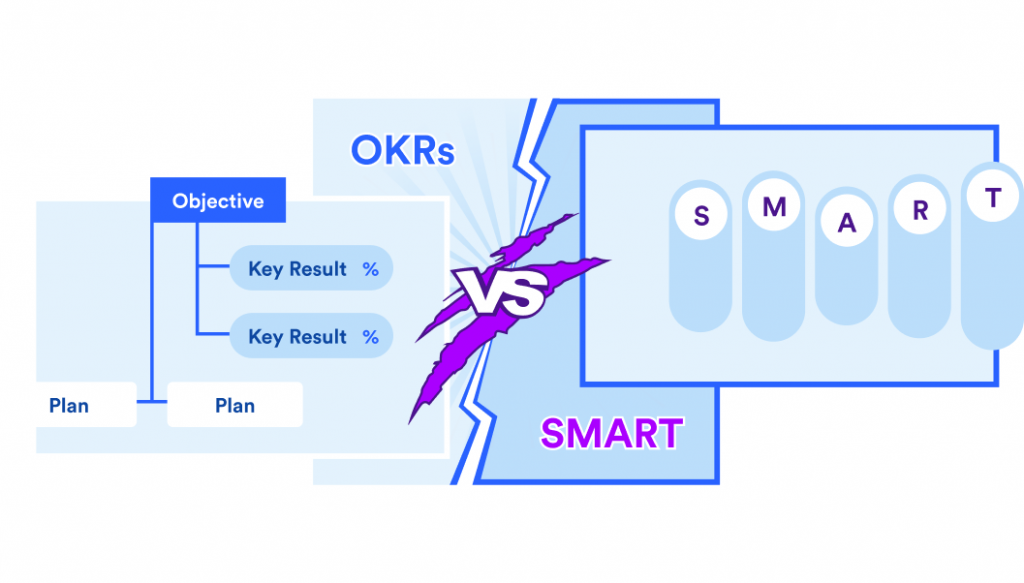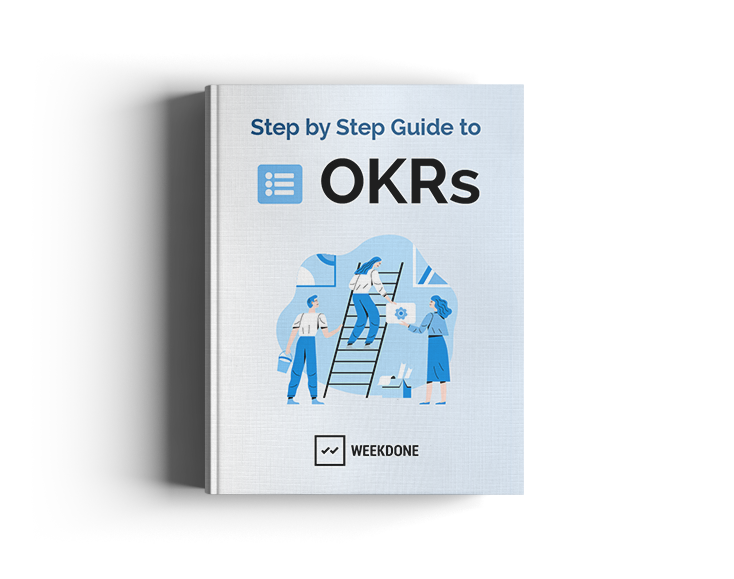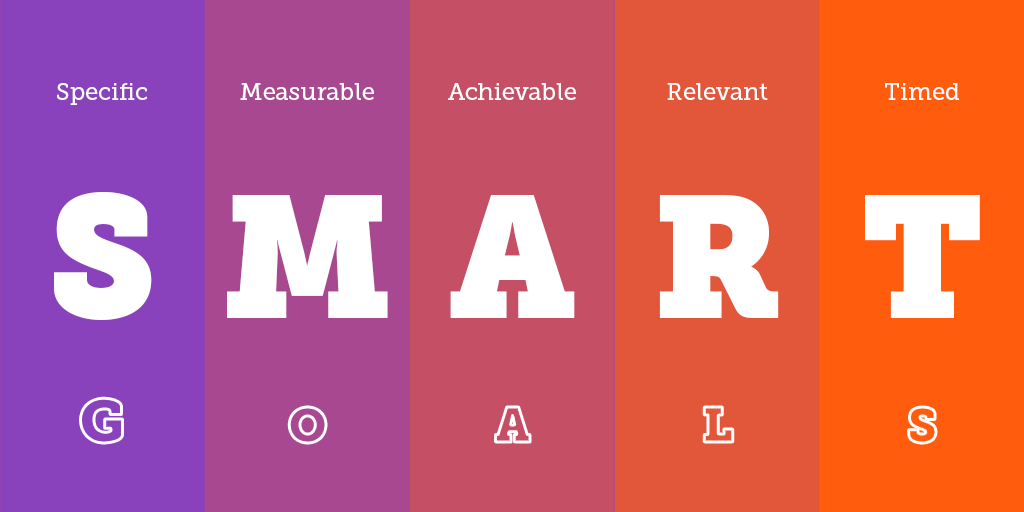On a surface level, OKRs and SMART goals may look quite similar. After all, they are both goal-setting methods. However, their purposes and use cases are completely different, and OKR is considered to be a more sophisticated approach for company-wide goal-setting.
OKRs are meant to drive companies to growth and sustainable improvement. They work best with the quarterly goal-setting cadence and regular weekly check-ins for updating progress and staying on the right track.
SMART goals are one-off goals set for smaller projects and they don’t have any direct or established connection to higher-level goals.

What are OKRs?
OKR stands for “Objective and Key Results.” It is a goal-setting system that focuses on improvement and growth. OKRs help companies to achieve alignment and engagement around measurable outcomes that really matter.
Objective and Key Results as a methodology can bring great success if the best practices and principles are being followed. One such principle is that OKRs are normally set on a company and a team level, while individual team members would have tasks and initiatives to drive the progress of the team’s OKR.
Personal OKRs do not bring much value to the business as individuals should be working collaboratively to achieve the outcomes that matter to the team.
OKRs can be used in different organizations starting from big software companies to small marketing teams or even NGOs. The size and field of the organization is not a limitation. The important prerequisite is cultural readiness and motivation to go through the needed changes.
📚 Read more: the meaning of OKR for different levels within your organizational structure
Company Objectives are overarching quarterly focus areas that need improvement and they set the direction for the teams.
Team OKRs are collaborative improvements that align with the Company Overarching Objective. Quarterly Team Objective answers to the question:
Which problem are you solving or which opportunity are you going to explore as a team?
It should be a motivational, qualitative statement that provides clarity and a sense of direction.
Team Key Results measure the success or failure of an Objective. They are always either measurable or quantifiable and focus only on outcomes.
Efficient Key Results are ambitious but yet achievable. They definitely are not the same as KPIs nor are they the same as projects. Key Results are always bound to the quarter as well as the Objectives.
OKRs have been adopted by a significant number of large enterprises and nonprofit organizations, including Netflix and Code for America.
An example of when to use OKRs
The definition of OKRs may seem a little too vague and theoretical– that’s why examining examples is key to understanding the merit of this approach.
Let’s look at an OKR example of a production company’s business development team.
Management has decided that it’s time to accelerate growth and, after evaluating different options, the business development team agreed that expanding to the European market is the best option.
Objective: Successfully Expand to European Markets
Good Objectives are clear, ambitious, and bring business value. They do not include numbers, are not the same as project headlines, and shouldn’t be vague as “Achieve growth”. Learn more about what good Objectives are about.
After the Objective is set it is time to think about the measurable and outcome-focused Key Results. How will we know that our European launch has been successful enough? What results would make us happy and contribute enough to the company’s growth?
Key Results:
- Choose the top country for the launch and sign a contract with at least 5 resellers
- Achieve an average order value of 50k
- Work closely with resellers and sell out first orders within 14 (maximum of 21) days
Conclusion: If this OKR is achieved, then the company will have successfully expanded to the European market which will help them to grow faster.

This one is a “How-to” guide to get started with OKRs and to help your team or a company implement the best goal setting system currently out there. Filled with a lot of practical example Objectives and Key Results it’s a good quick handbook to launch and implement OKRs in your team.
What are SMART goals?

SMART is a goal-setting approach that allows you to specify what you want to achieve.
SMART goals are set by following 5 key principles:
- Specific. What do you really want to achieve?
- Measurable. What are your numeric expectations or limitations (level of effort, time, and cost)?
- Attainable. Is it realistic?
- Relevant. Is the goal really relevant to you and your business?
- Time-bound. What are your deadlines, timelines, and measurable time restrictions?
SMART goals are guidelines and a descriptive set of rules to apply when you are thinking about what you want to achieve, and they do not have any particular cadence or use case. You can set them for needed periods and for teams, individuals or just projects. Usually, there’s no certain alignment between different levels of SMART goals.
An example of when to use SMART goals
Finance website DollarSprout used the SMART goal-setting process in the past to reach a search engine traffic goal.
Goal: Increase Overall Search Engine Traffic by 10% Within Two Months
- Specific: DollarSprout will increase search engine traffic by 10% in two months.
- Measurable: Re-optimize five excellent and proven successful pieces of content in order to aid ten backlinks to that specific content.
- Attainable: If every member of the editorial team pitches ideas for improving the copy, this goal is extremely realistic and viable.
- Relevant: Search engine traffic provides the most traffic to our website. This goal plan is the most efficient and likely way for us to increase our organic traffic. As a result, this goal directly translates into overall business success.
- Timely: This goal will be accomplished during the next two months.
Conclusion: Within two months, DollarSprout will increase its search engine traffic by 10%. This will be done by focusing on re-optimizing current content and putting effort into earning at least ten backlinks to that established content.
OKR vs SMART goals: What are the main similarities?
Either of these goal-setting approaches are developed under the notion that goals are absolutely crucial to achieving business and organizational success. While they do differ pretty significantly, both are guiding you to flesh out a goal and the plan needed to reach that goal in a realistic and timely fashion.
Both OKR and SMART goals involve removing the “vague” factor from setting and reaching goals. Both focus on measuring success based on outcomes, not just the amount of completed activities.
Both approaches teach you to be specific, but OKRs allow the teams to envision their role in achieving Company Objectives, and acknowledge that there always is a multitude of different factors contributing to a team’s success.
OKRs also offer a specific process to follow, while SMART goals are very often ad-hoc combinations of long-term and short-term projects of mixed significance and little or no consideration for a bigger picture.
OKR vs SMART goals: What are the main differences?
SMART goals do not help to achieve clear and well-pronounced alignment in a company. In an organizational setting, very often the number of SMART goals can become unmanageable and confusing. So SMART goals may be good enough for individual use but extremely unmanageable for businesses.
OKR provides a clear structure for organizational goal-setting and requires critical evaluation of what matters most to the business. OKRs also work best with established weekly planning and check-in strategy.
So the OKR approach requires a management process, proper implementation, and dedication while SMART goals can be set by employees whenever they want.
Different dedication brings also different benefits. SMART goals just discipline the team or an individual around one small goal that might not have any connection with what the rest of the company is doing. OKRs are a systematic approach to improve the company as a whole. Team OKRs are aligned with company Objectives and all of the OKRs are visible to everyone in the organization. That gives employees a clear understanding of what other teams are doing and how they as a team are contributing to higher-level goals.
This is why OKRs are more effective than SMART goals if we look at both of them from an organizational perspective. OKRs bring more business value and help companies and teams to grow and improve.
👉If you’re considering using OKRs for your company and teams, be sure to sign up to Weekdone – an OKR tool designed to help you learn, implement and track your Company & Team-level OKRs.👈
Invite your teams for a company trial – all features free for 14 days